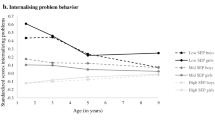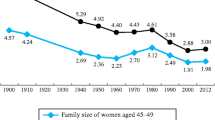Abstract
Kanner, in his 1943 article, reported that parents of autistic children tended to be of high socioeconomic status (SES). According to Schopler, Andrews and Strupp (1979), subsequent studies did not reveal similar findings. However, a careful analysis of these studies will show that in all instances the SES distributions of the parents were bimodal. The evidence shows that when Kanner's strict criteria are used, parents of autistic children are of higher SES. However, when children withautistic features are included in the first group, bimodal distributions are obtained. It is suggested that the question of upper SES of parents of autistic children is still open.
Similar content being viewed by others
References
Anthony, J: An experimental approach to the psychotherapy of childhood autism.British Journal of Medical Psychology, 31:211–225, 1958.
Bender L, Grugett A E: A study of certain epidemiological factors in a group of children with childhood schizophrenia.American Journal of Orthopsychiatry, 26:131–145, 1956.
Campbell M, Hardesty A S, Burdock E I, Polevoy N T, Geller B: Selected peri-, and postnatal and demographic characteristics of autistic children. Paper presented at the Annual meeting of the American Academy of Child Psychiatry, Dallas, Texas October, 1977.
—, Hardesty A, Burdock E: Domographic and prenatal profile of 105 autistic children: A preliminary report.Psychopharmacology Bulletin, 14:36–39, 1978.
Cantwell D P, Baker L, Rutter M: Family factors. In:Autism, A Reappraisal of Concepts and Treatment, eds. M. Rutter and E. Schopler. New York: Plenum Press 1978.
Cox A, Rutter M, Newman S, Bartak L: A comparative study of infantile autism and specific developmental receptive language disorder: II. Parental characteristics.British Journal of Psychiatry, 126:146–159, 1975.
Creak M., Ini S: Families of psychotic children.Journal of Child Psychology and Psychiatry, 1:156–175, 1960.
Gillberg C, Schaumann H: Social class and infantile autism.Journal of Autism and Developmental disorders, 12:223–228, 1982.
Kanner L: Autistic disturbances of affective contact.Nervous Child, 2:217–250, 1943.
—: Problems of nosology and psychodynamics of early infantile autism.American Journal Orthopsychiatry, 19:416–426, 1949.
—: To what extent is early infantile autism determined by constitutional inadequacies? Proceedings of theAssociation of Research in Nervous and Mental Disorders, 33:378–385, 1954.
—:Childhood Psychosis: Initial Studies and New Insight. Washington DC: V H Winston, 1973a.
—: Children have not read those books. In:Childhood Psychosis. Ed. L. Kanner Washington DC: V H Winston, 1973b.
King P D: Early infantile autism: Relationship to schizophrenia.Journal of the American Academy of Child Psychiatry, 14:666–682, 1975.
Kolvin I, Ounsted C, Richardson L M, Garside R F: Studies in childhood psychoses: III. The family and social background in childhood psychoses.British Journal of Psychiatry, 118:396–402, 1971.
Lotter V: Epidemiology of autistic conditions in young children: II. Some characteristics of the parents and children.Social Psychiatry, 1:163–173, 1967.
Lowe L H: Families of children with early childhood schizophrenia: Selected demographic information.Archives of general Psychiatry, 14:26–30, 1966.
McDermott J F, Harrison S I, Schrager J, Lindy J, Killins E: Social Class and mental illness in children: The question of childhood psychosis.American Journal of Orthopsychiatry, 37:548–557, 1967.
Ornitz E M, Ritvo E R: Perceptual inconstancy in early infantile autism.Archives of General Psychiatry, 18:76–98, 1968.
Pitfield M, Oppenheim A N: Child rearing attitudes of mothers of psychotic children.Journal of Child Psychology and Psychiatry, 5:51–57, 1964.
Prior M R, Gajzago C C, Knox D T: An epidemiological study of autistic and psychotic children in the 4 eastern states of Australia.Australian and New Zealand Journal of Psychiatry, 10:173–184, 1976.
Rimland B: Infantile autism: Status and research. In:Child Personality and Psychopathology Ed., Davids A, 1974.
—:Infantile Autism. New York: Appleton-Century-Crofts, 1964.
Ritvo E D, Cantwell D, Johnson E, Clements M C, Benbrook F, Slagel S, Kelly P, Ritz M: Social class factors in autism.Journal of Autism and Childhood Schizophrenia, 1:297–310, 1971.
Rutter M, Lockyer L: A five to fifteen year follow-up of infantile psychosis: I. Description of sample.British Journal of Psychiatry, 113:1169–1182, 1967.
—, Garmezy N: Developmental psychopathology In:Handbook of Child Psychology, eds., Mussen P H Hetherington, E M New York: John Wiley, 1983.
Schain R J, Yannet H: Infantile autism: An analysis of 50 cases and a consideration of certain relevant neurophysiologic concepts.Journal of Pediatrics, 57:560–567, 1960.
Schopler E, Reichler R J, Devellis R F, Daly K: Toward objective classifications of childhood autism: Childhood autism rating scale (CARS).Journal of Autism and Development Disorders, 10:91–103, 1980.
—, Andrews E C, Strupp K: Do autistic children come from upper-middle class parents?Journal of Autism and Developmental disorders, 9:139–152, 1979.
Treffert D A: Epidemiology of infantile autism.Archives of General Psychiatry, 22:431–438, 1970.
Tsai L, Stewart M A, Faust M, Shook S: Social class distribution of fathers of children enrolled in Iowa program.Journal of Autism and Developmental disorders, 12:211–221, 1982.
Von Brauchitsch H K, Kirk W E: Childhood schizophrenia and social class.American Journal of Orthopsychiatry, 37:400, 1967.
Ward T F, Hoddinott B A: A study of childhood schizophrenia and early infantile autism: Part I. Description of the sample: Part II. Selection of a group for in-patient treatment. Canadian Psychiatric Association Journal, 10:377–386, 1965.
Wing L: Childhood autism and social class: A question of selection?British Journal of Psychiatry, 137:410–417, 1980.
— Yeats S, Brierley L M, Gould J: The Prevalence of early childhood autism: Comparison of administrative and epidemiological studies.Psychological Medicine, 6:89–100, 1976.
Wolff S, Chess S: A behavioral study of schizophrenic children.Acta Psychiatrica Scandinavica, 40:438–460, 1960.
Author information
Authors and Affiliations
Rights and permissions
About this article
Cite this article
Sanua, V.D. Infantile autism and parental socioeconomic status: A case of bimodal distribution. Child Psych Hum Dev 17, 189–198 (1987). https://doi.org/10.1007/BF00706229
Received:
Accepted:
Issue Date:
DOI: https://doi.org/10.1007/BF00706229




